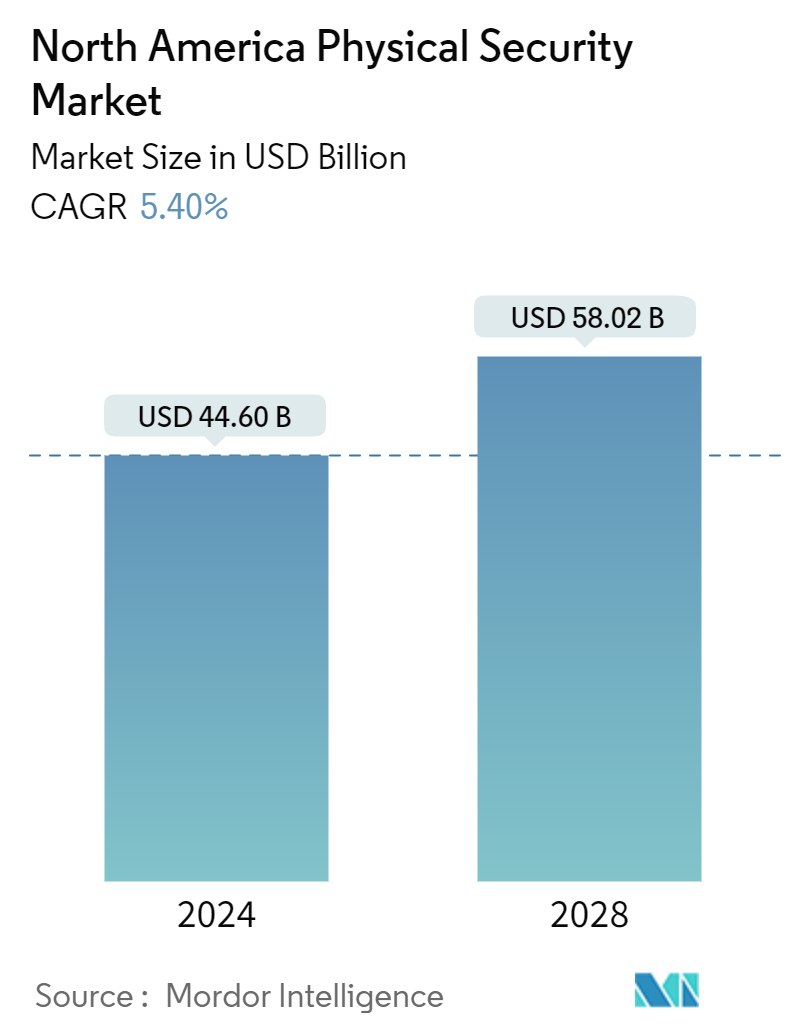Market Size of North America Physical Security Industry

| Study Period | 2022 - 2029 |
| Base Year For Estimation | 2023 |
| Market Size (2024) | USD 44.60 Billion |
| Market Size (2029) | USD 58.02 Billion |
| CAGR (2024 - 2028) | 5.40 % |
| Market Concentration | Low |
Major Players
*Disclaimer: Major Players sorted in no particular order |
North America Physical Security Market Analysis
The North America Physical Security Market size is estimated at USD 44.60 billion in 2024, and is expected to reach USD 58.02 billion by 2029, growing at a CAGR of 5.40% during the forecast period (2024-2029).
- Physical security is the safeguarding of organizational resources from harm caused by physical occurrences. These occurrences may include natural disasters, such as fires or floods, manufactured threats, such as theft and vandalism, accidents, and accidental damage. Organizations are increasingly relying on the Internet of Things (IoT) and its associated integrations, necessitating enhancing their digital and physical security controls. Virtual computers and applications, whether hosted in the cloud or not, are just as secure as physical servers.
- Physical security systems, including video analytics, IP Cameras, and video management systems, are anticipated to become one of the most promising technologies for enhancing city public safety. Public safety organizations and governments are investing in cutting-edge physical security systems and software to improve productivity and monitor significant transportation hubs.
- The significance of safeguarding the physical environment against crimes like burglaries, theft, vandalism, and fire cannot be emphasized enough. This aspect is expected to significantly contribute to the market's growth. Furthermore, the market is anticipated to gain advantages from technological advancements and innovations in integrated video, sensors, and access systems for Internet of Things (IoT) enabled devices.
- Due to the rise in terrorist and criminal activities, there has been a heightened sense of concern among individuals, procedures, and resources in terms of safety and security. These unfortunate incidents have caused significant damage to various infrastructures and resulted in the loss of countless lives, emphasizing the urgent requirement for physical security measures.
- By combining AI, ML, and analytics with surveillance, numerous untapped potentials can be explored, including the ability to predict crimes and identify ongoing criminal activities in real time. The security team effectively integrates AI-based analytics with surveillance to monitor various potential situations.
- For instance, in June 2023, physical security systems such as surveillance cameras, designed to combat violent crime in cities throughout the United States, were utilized to punish and evict public housing project residents. Across the United States, public housing facilities are being equipped with a new generation of intrusive and powerful surveillance systems, placing excessive control over some of the nation's most vulnerable citizens.
- The government and the relevant regulatory bodies have been urged to install security measures to reduce property damage caused by criminals and other crimes. For example, in July 2023, the Canada Police Board requested 14 new cameras from the police force as part of the 10-year annual capital budget forecast. Tools such as Closed-Circuit Television can assist police in deterring crime, apprehending those who commit crimes, and coordinating and distributing resources.
- North America witnessed the highest global adoption rate of intelligent city infrastructure and technologies. Smart America estimates that US city governments will allocate approximately USD 41 trillion to modernize their infrastructure to capitalize on the Internet of Things (IoT) over the next two decades. A combination of technological developments, real-time access, wireless integration, video analysis, the cost-effectiveness of IP surveillance, and governmental initiatives has positively impacted the implementation of physical security in North America.
North America Physical Security Industry Segmentation
Physical security refers to preventing unauthorized intruders from accessing controlled facilities. Physical security technologies have developed significantly recently, offering advanced protection at competitive prices. Physical security devices utilize cloud technology and AI for even more sophisticated real-time data processing. Various automated physical security components can perform multiple functions in a physical security system.
The North American physical security market is segmented by system type (video surveillance system [IP surveillance, analog surveillance, and hybrid surveillance], physical access control system (PACS), biometric system, perimeter security, and intrusion detection), service type (access control-as-a-service (ACaaS) and Video Surveillance-as-a-Service (VSaaS)), type of deployment (on-premises and cloud), organization size (SMEs and Large Enterprises), end-user industry (government services, banking and financial services, IT and telecommunications, transportation and logistics, retail, healthcare, residential, and other end-user industries), and country (the United States and Canada). The report offers the market sizes and forecasts for all the above segments in terms of value (USD).
| By System Type | |||||
| |||||
| Physical Access Control System (PACS) | |||||
| Biometric System | |||||
| Perimeter Security | |||||
| Intrusion Detection |
| By Service Type | |
| Access Control as a Service (ACaaS) | |
| Video Surveillance as a Service (VSaaS) |
| By Type of Deployment | |
| On-Premises | |
| Cloud |
| By Organization Size | |
| SMEs | |
| Large Enterprises |
| By End-user Industry | |
| Government Services | |
| Banking and Financial Services | |
| IT and Telecommunications | |
| Transportation and Logistics | |
| Retail | |
| Healthcare | |
| Residential | |
| Other End-user Industries |
| By Country | |
| United States | |
| Canada |
North America Physical Security Market Size Summary
The North American physical security market is poised for significant growth, driven by the increasing need to safeguard organizational resources from various physical threats, including natural disasters and criminal activities. As organizations increasingly integrate Internet of Things (IoT) technologies, there is a heightened focus on enhancing both digital and physical security measures. The market is witnessing substantial investments in advanced physical security systems, such as video analytics, IP cameras, and video management systems, which are becoming integral to improving public safety and monitoring critical infrastructure. The urgency for robust security measures is further amplified by the rise in terrorist and criminal activities, prompting both public and private sectors to adopt sophisticated surveillance solutions to protect assets and ensure safety.
The market landscape is characterized by a competitive environment with numerous players striving to expand their market presence through innovative product offerings and strategic partnerships. Key industry participants, including Bosch Security Systems, Genetec Inc., and Honeywell International, are actively involved in developing and deploying advanced security solutions. The adoption of AI, machine learning, and analytics in surveillance systems is unlocking new possibilities for real-time crime prediction and prevention. Additionally, the integration of biometric technologies and cloud-based monitoring systems is enhancing the effectiveness of physical security measures across various sectors, including retail, transportation, and public safety. As North America continues to lead in the adoption of intelligent city infrastructure, the demand for comprehensive physical security solutions is expected to grow, supported by technological advancements and government initiatives.
North America Physical Security Market Size - Table of Contents
-
1. MARKET INSIGHTS
-
1.1 Market Overview
-
1.2 Industry Attractiveness - Porter's Five Forces Analysis
-
1.2.1 Bargaining Power of Suppliers
-
1.2.2 Bargaining Power of Consumers
-
1.2.3 Threat of New Entrants
-
1.2.4 Threat of Substitutes
-
1.2.5 Intensity of Competitive Rivalry
-
-
1.3 Impact of COVID-19 Aftereffects and Other Macroeconomic Factors on the Market
-
-
2. MARKET SEGMENTATION
-
2.1 By System Type
-
2.1.1 Video Surveillance System
-
2.1.1.1 IP Surveillance
-
2.1.1.2 Analog Surveillance
-
2.1.1.3 Hybrid Surveillance
-
-
2.1.2 Physical Access Control System (PACS)
-
2.1.3 Biometric System
-
2.1.4 Perimeter Security
-
2.1.5 Intrusion Detection
-
-
2.2 By Service Type
-
2.2.1 Access Control as a Service (ACaaS)
-
2.2.2 Video Surveillance as a Service (VSaaS)
-
-
2.3 By Type of Deployment
-
2.3.1 On-Premises
-
2.3.2 Cloud
-
-
2.4 By Organization Size
-
2.4.1 SMEs
-
2.4.2 Large Enterprises
-
-
2.5 By End-user Industry
-
2.5.1 Government Services
-
2.5.2 Banking and Financial Services
-
2.5.3 IT and Telecommunications
-
2.5.4 Transportation and Logistics
-
2.5.5 Retail
-
2.5.6 Healthcare
-
2.5.7 Residential
-
2.5.8 Other End-user Industries
-
-
2.6 By Country
-
2.6.1 United States
-
2.6.2 Canada
-
-
North America Physical Security Market Size FAQs
How big is the North America Physical Security Market?
The North America Physical Security Market size is expected to reach USD 44.60 billion in 2024 and grow at a CAGR of 5.40% to reach USD 58.02 billion by 2029.
What is the current North America Physical Security Market size?
In 2024, the North America Physical Security Market size is expected to reach USD 44.60 billion.

